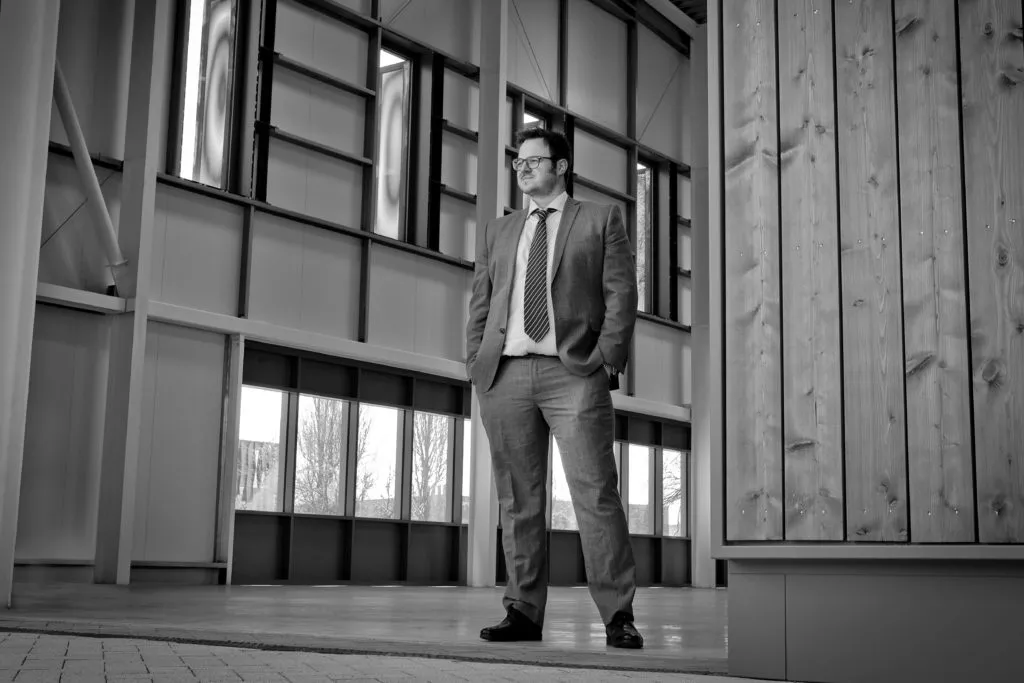
Harwell Campus Pandemic Pioneer – David Payne
Third up in our Pandemic Pioneers series is David Payne. A Professor of Materials Chemistry at Imperial College London and Director at The Research Complex at Harwell, and someone who has performed a heroic if undercelebrated role in the fight against Covid-19.
“I don’t think our default setting is we exist between pandemics. It’s the other way around. We live our lives and pandemics happen.”
So says David Payne, the softly-spoken 38-year-old Director of the Research Complex at Harwell, a science-led national resource based at the Harwell Science and Innovation campus just outside Oxford.
“Research Complex is a meeting of minds” says Payne. “We have a mix of physicists, chemists, structural biologists, all manner of different people across life and physical sciences.”
Research Complex is a UK Research and Innovation-funded facility, with six stakeholders including MRC, BBSRC, STFC, EPSRC, NERC, Diamond Light Source – “a lot of acronyms” admits Payne – and over 20 universities performing research in the building.
Its primary role, explains Payne, is to bring scientists together.
“Not only are they close to all of this fantastic national infrastructure, delivering world-class lasers, X-rays and neutrons, but it’s being co-located and the opportunity to collaborate. There’s a sense of spirit of collaboration that we want to foster.”
Research Complex has so far performed a heroic if undercelebrated role in the fight against Covid-19.
“There are at least five publications in a range of different areas, structure, determination of Covid-19, some antibody work, nanobody work, microscopy work. Looking at Covid all the way down to the cellular, the structural biology level. One of the researchers has been imaging lung tissue at a facility in France. Research Complex has been involved every step of the way.”
Then there are the llamas.
The Rosalind Franklin Institute and Protein Production UK, who were based at Research Complex before recent completion of their new building, have been working together on the Harwell campus to fight Covid-19 with the help of samples from llamas, located at nearby Reading University.
“There are certain cameloid nanobodies which are present in llamas which are very useful” says Payne.
“The use of llamas and the development of these nanobodies is certainly going to have an impact in the treatment of Covid.”
Payne is also Professor of Materials Chemistry at Imperial College London, running a research group there in parallel and joined Research Complex in October 2019. By his own admission, it was a fiery baptism.
“Nobody in living memory has had to deal with a pandemic on this scale” he admits.
“Having to make decisions, where you’re unsure of the impact. My absolute priority was to stay open, be safe and scientifically productive.”
The pandemic hit Research Complex hard. Its labs, once teeming with PhD and post-doctoral students, became very quiet.
“There were certain moments where I thought, this is almost surreal” admits Payne.
But Payne, whose Welsh father and grandfather have run a family business for many decades, took a business approach.
“I learned it’s important to rapidly implement positive changes” he says. “Not spend too long agonizing. You have to make rapid decisions.”
Payne introduced a series of radical anti-Covid measures with the fantastic and dedicated support of the hard-working core-team, who help him run Research Complex.
“We brought in mandatory masking in the middle of May 2020. I like to think we were slightly ahead there.”
He also replaced entry buttons with infra-red sensors and installed gel-dispensing handles on toilet doors.
“We also implemented a software solution to book lab spots. We’ve had 17 and a half thousand bookings so far on that system since June 2020. That’s 17 and a half thousand days of people doing individual scientific experiments. That’s a lot of science!” he says proudly.
“I don’t think like a normal scientist” admits Payne.
And he fervently believes scientific endeavour benefits from human interaction.
“I want an environment that is stimulating and creative and productive for everyone. The scientific laboratory is just another part of the human experience – where people come together to work and be creative together – that’s where you get the most creative spark.”
So is scientific accomplishment best served by randomness, or human endeavour, or both?
Payne demurs.
“I don’t know. But that’s the beauty of serendipity. Shouldn’t a research lab try to engineer as much serendipity as possible?” he asks.
Payne admits his proudest achievement is creating an environment in which scientists can simply “come in and be productive.”
Will there be positive changes in our working practices, going forward?
“Yes for sure. There may be new ways of doing things that may stay with us. Working from home will increase. And us thinking about hygiene is a good thing and that will continue.”
But what for the future? Are there risks, and consequences in going back to work?
“It’s worth taking the risk because the synergy is so important to humanity in general” he claims.
“We will return to normal, I believe. Human beings have returned to normal after every pandemic we’ve gone through and this will be no different. At some point we’re all going to have to flip from the pandemic dominating our thoughts, to a time when it is not.”